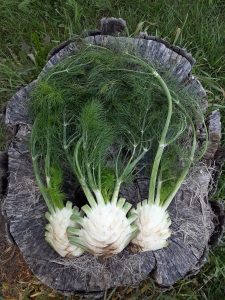
“In seed time learn, in harvest teach, in winter enjoy.”

- Fennel – All Shares
- Summer Squash/Zucchini – All Shares
- Peppers (Poblano, Italian Frying, & Hot Wax and/or Cayenne and/or Habanero) – All Shares
- Tomatoes – All Shares
- Chard – All Shares
- Eggplant – All Shares
- Potatoes – Full and Half Shares
- Radishes – Full and Half Shares
- Red Kale – Full Shares
- Purple Carrots – Full Shares
- Watermelon – Flex Shares
- Spaghetti Squash – Flex Shares
- Okra – Flex Shares
- Sweet Onions – Flex Shares
Farmer Notes
Fennel is a flowering plant in the Apiaceae family (the family that also includes carrots, dill, parsley, coriander) that is often overlooked and underrated. However, it is not as intimidating as it looks! Native to the Mediterranean region, this plant is most popular in Italy. As it gains insurgence, it is also becoming widely known and cultivated as both an herb and a vegetable throughout the diaspora. The most common type of fennel, Florence fennel, is often characterized by its distinct bulb-like base that weaves together and grows above the ground, tall stalks that resemble celery and flowering leaves that look like dill. Despite its looks, however, it is not a root vegetable.
While the entire plant is edible from its leaves all the way down to its bulbs and can be eaten both raw and cooked, most recipes only call for the bulb. When eaten raw, fennel has a crisp texture that resembles a mix of celery and licorice. It also caramelizes as it cooks, taking on a brighter and sweeter flavor. Fennel is a perfect addition to salads, roasts, stews and pork dishes.
Fennel is as nutritious as it is delicious. One cup of fennel contains around 20 percent of your recommended daily value of vitamin C. Outside of that, fennel also contains plenty of iron, fiber, potassium, vitamin A and calcium. Fennel is also heart healthy. It is a low cholesterol food that is also low in calories. Fennel also contains high levels of essential nitrates and is a great source of natural estrogen. Outside of dietary uses, fennel is also used in tea to help treat digestive issues, menstrual cramps, boost weight loss and prevent heartburn.
Fennel maintains its freshness best when stored in a cooler temperature. Keeping it in a refrigerator is your best bet. To properly store fennel, trim the stalks above the bulb and wrap the bulb loosely in a plastic bag. This can be stored in the fridge for 5-10 days depending on how fresh the fennel is.
I hope you have fun experimenting and creating new dishes and recipes with this exciting and exotic vegetable! I know I personally haven’t heard of this plant until recently but I am excited to continue to learn more about it.
~Evette
Some recipes to try:
[ultimate-recipe id=”8591″ template=”default”]
[ultimate-recipe id=”4872″ template=”default”]
[ultimate-recipe id=”7006″ template=”default”]


